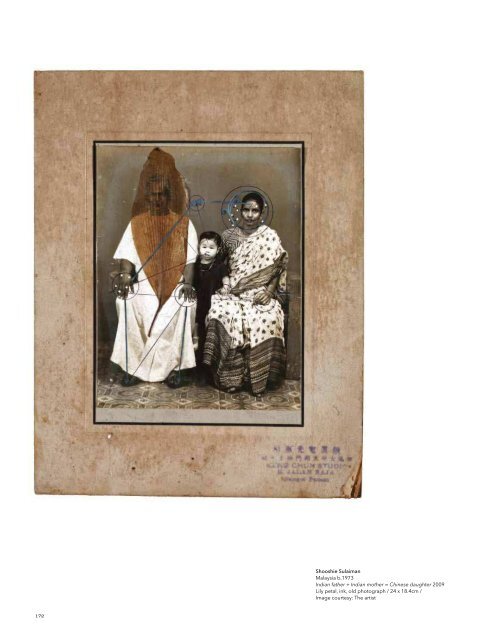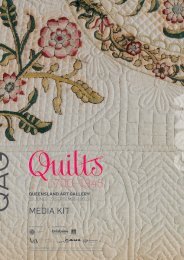Queensland Art Gallery - Queensland Government
Queensland Art Gallery - Queensland Government
Queensland Art Gallery - Queensland Government
Create successful ePaper yourself
Turn your PDF publications into a flip-book with our unique Google optimized e-Paper software.
Shooshie Sulaiman<br />
Who’s afraid of the dark?<br />
My father, of Scottish heritage, is a great storyteller, and I have many<br />
eloquent memories of him telling stories about his life. My parents<br />
have always been very open and no question was taboo in our<br />
household. There was, however, one question I never posed — about<br />
my mother’s life in Malaysia. She was born in Malaysia to Chinese<br />
parents and came to Australia to attend university in the 1970s, but all<br />
other details are shrouded in darkness.<br />
I was the only child with Chinese heritage at my small primary school<br />
in far north <strong>Queensland</strong>. Apart from my mother’s face, the faces on<br />
the nightly news were the only representations of Chinese and Malay<br />
people that I was familiar with. Many years later, I still feel a sense of<br />
the unfamiliar while viewing Shooshie Sulaiman’s Darkroom 2009, an<br />
installation of photographic portraits of men and women from around<br />
Malaysia, posed alone, in pairs and in groups.<br />
Sulaiman found these portraits of nameless people in second-hand<br />
stores around Malacca. The portraits, dating from the 1950s and 1960s<br />
with their sepia tones, reference the time preceding the 13 May 1969<br />
race riots. 1 Sulaiman was born after the riots, but lives with their legacy as<br />
a person of both Malay and Chinese heritage. In Darkroom, she brings<br />
together approximately 50 portraits, transforming the faces of the portrait<br />
sitters using flower petals, collage, ink and paint, and mounting the<br />
images in found frames. The petals of pressed lily, lotus, poppy, tulip and,<br />
particularly, the hibiscus are used to soften the faces of the male figures.<br />
Hibiscus rosa-sinensis is the national flower of Malaysia, although<br />
it is not native to the country. Its five petals represent the nation’s<br />
five principles: belief in God, loyalty to king and country, upholding<br />
the constitution, the sovereignty of the law, and good behaviour<br />
and morality. These were first announced at Independence Day<br />
celebrations in 1970 in response to the events of 1969. Sulaiman’s use<br />
of single hibiscus petals in Darkroom is thus a subtle device through<br />
which she questions Malaysia’s national principles and laws.<br />
people. Single group photographs tend to display a false sense of<br />
unity; although the family is all smiles, many other frames reveal frowns<br />
and tensions. Portraits of a nation also tend towards a false sense<br />
of unity. The Malaysian <strong>Government</strong> describes the nation as a place<br />
where ‘Malays, Chinese, Indians and many other ethnic groups . . . have<br />
influenced each other, creating a truly Malaysian culture’. 2 It may be<br />
argued that Darkroom, as a collection of nameless faces, is better able<br />
to display the diversity and multiplicity of stories — as well as hint at the<br />
lost ones — that create the Malaysian national portrait.<br />
The portraits of these nameless faces are installed in an ‘open house’, a<br />
replication of the library in Sulaiman’s former Kuala Lumpur residence,<br />
a small wooden building behind the National <strong>Art</strong> <strong>Gallery</strong> and the<br />
National Theatre — two of Malaysia’s major art institutions. The ‘open<br />
house’ is an ongoing metaphor in Sulaiman’s work — she makes herself<br />
and her work accessible via open spaces. She opens her home for art<br />
exhibitions, in keeping with the Malaysian festive tradition of opening<br />
your home to family, friends and strangers to celebrate cultural or<br />
religious festivities. For Darkroom, Sulaiman opens the doors of her<br />
library to us, inviting us to join her in celebrating the ambiguous and<br />
fractured nature of Malaysian identity.<br />
Ellie Buttrose<br />
Endnotes<br />
1 On 13 May 1969, following the 10 May Malaysian general election, Chinese–Malay<br />
race riots broke out in Kuala Lumpur. A state of emergency was declared, and there<br />
were officially around 200 deaths, although unofficial figures are far greater.<br />
2 Tourism Malaysia, <br />
viewed October 2009.<br />
Shooshie Sulaiman<br />
Malaysia b.1973<br />
Indian father + Indian mother = Chinese daughter 2009<br />
Lily petal, ink, old photograph / 24 x 18.4cm /<br />
Image courtesy: The artist<br />
Women are chronically under-represented in some aspects of Malaysian<br />
society, especially in politics, where they make up only ten per cent of<br />
parliament. Sulaiman counters this by using flower petals to soften the<br />
dominant representation of men, and brings women’s issues to the<br />
surface by painting over the women’s portraits with red ink, with titles<br />
like ‘menstruation’. Sulaiman is also interested in the slippage that occurs<br />
in the process of trying to define genders, which, like race, dominates<br />
identity politics. She creates ambiguity by partially covering female<br />
portraits with paper laden with text and titling them ‘masculine’, and<br />
using flower petals as a mechanism for feminising the male portraits.<br />
My parents, sister and I have very rarely been captured in the same<br />
frame. Our collection of photographs of us in pairs or trios is better<br />
able to represent my family as a group of related but independent<br />
172 173
















